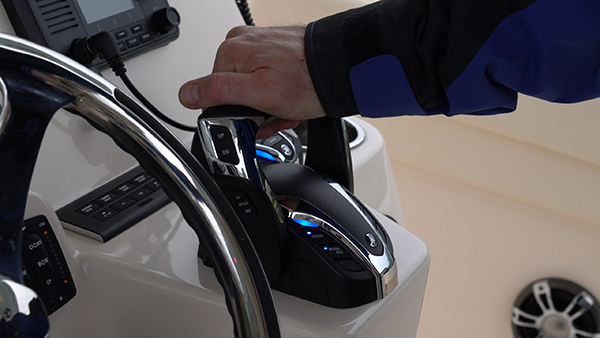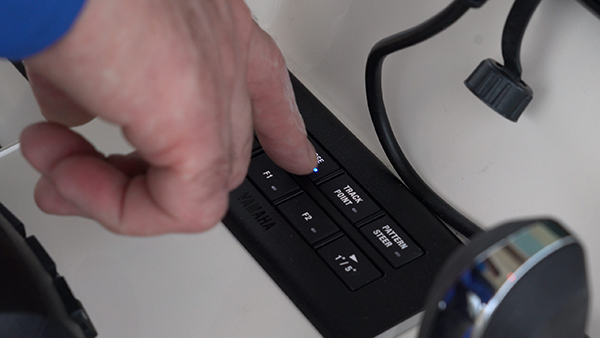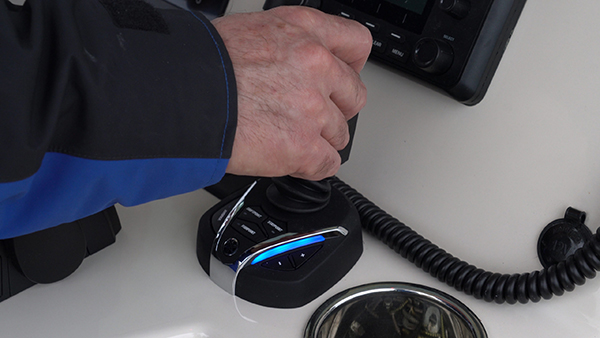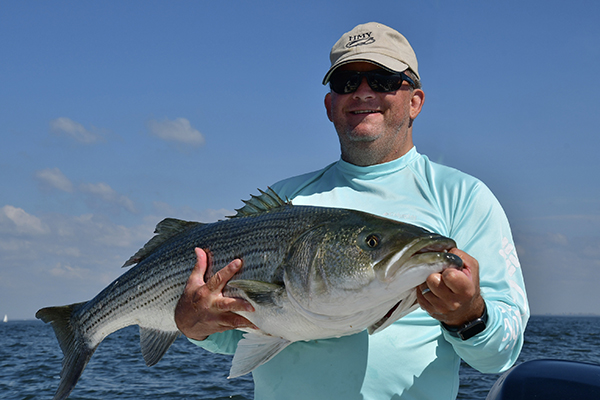One of the most common techniques for catching fish in both fresh and saltwater is trolling. Whether you’re fishing for walleye on a midwestern lake or marlin far offshore, trolling can provide the most consistent return in hookups and landings during your time on the water. Trolling allows an angler to cover more water while presenting multiple baits and is applicable to a wide variety of species. You can troll using lures, live bait, rigged dead bait or some combination. While the basic concept of using the boat to pull your offerings remains constant, the tackle and how the boat should be set up and used may vary.
Even though trolling requires your boat and engine to be active partners in the fishing process, there have been surprisingly few advancements in outboard engine technology that significantly improve trolling efficiency and success. However, Yamaha’s Helm Master® EX Full Maneuverability package is a game changer - a tool for trolling that provides precise, virtually hands-free vessel speed and directional control while fishing.

The complete Helm Master® EX system consists of electronic steering, digital electronic shift and throttle binnacle, joystick, autopilot, GPS/heading sensor, CPU and touchscreen multifunctional display interfaced into a seamless operating environment that offers an array of navigational benefits. It’s available for boats powered by single and multiple Yamaha outboards from the four-cylinder F150 to the eight-cylinder XTO Offshore®. Until you’ve experienced the fishing benefits the system can provide, it’s difficult to fathom everything it can do. So, let’s look at how Helm Master® EX Full Maneuverability can enhance your fishing success by focusing on a variety of fishing scenarios in a continuing series of articles.
Late last fall we took delivery of a new saltwater test platform, a 2022 Pathfinder 2700 powered by a single F300 and equipped with the full suite of Helm Master® EX components. The boat is a 27-foot, twin-step V-hull fishing machine that straddles the line between large bay boat and offshore-capable center console. It can be used to challenge a variety of gamefish in environments that vary from shallow backwater tidal rivers and bays to offshore in the open ocean. Fishing out of the Northeast’s largest Yamaha repower center, Gateway Marina in Highlands, New Jersey, the boat is only a short run from some of the most incredible striped bass fishing to be found anywhere on the planet. We’ll start there. Keep in mind many of the techniques we will examine will be applicable to other gamefish and areas of the country. The technique covered in this installment is a prime example. We will touch on other fishing scenarios it can be applied to later in the article.
One of the most effective techniques for targeting big stripers through a substantial portion of the season is slow trolling live eels. Our trolling pattern consists of four side-planers, two that run off each side of the boat. Three-to-five additional outfits run down the center with large foam floats to set the eels at varying depths. The technique works best with monofilament line, we use 30-pound test, attached to a three-foot fluorocarbon leader with a mini-swivel ending in a large circle hook. Egg sinkers are placed between the running line and the swivel using various weights between one-quarter ounce and two-ounces, depending on how deep we want the eel to be suspended below the surface.
The difficult part of this technique is setting and maintaining the slow trolling speeds required—usually between one and two miles per hour—and directional control of the vessel while trolling. With traditional helm controls, someone had to be at the wheel constantly making throttle adjustments and course corrections to keep the trolling pattern properly deployed with the baits spread apart by the side planers and floats. If the speed is too slow, the boat loses directional control, the planers won’t pull the baits out away from the sides of the boat and lines will get tangled. If the speed is too fast, the eels will get dragged to the surface instead of running well below the floats. It’s a balancing act that can be difficult to maintain. Helm Master® EX, however, makes this technique much easier to execute.

After leaving the marina and slow wake zone, we powered up the Pathfinder, the F300 providing smooth and efficient thrust capable of a top speed of 52 miles-per-hour, and an efficient mid 30 mile-per-hour cruise at close to three miles per gallon. Once on station, a spot near the terminal end of a ship channel, we readied eight outfits and put the boat in gear. Using the Digital Electronic Control (DEC) binnacle shift and throttle, we set the speed at two miles-per-hour and engaged “Speed Control” using the rocker switch located on the left side of the shift and throttle lever on single engine Helm Master® EX system. Speed Control is akin to the cruise control system on your car or truck except it can be set either by speed or by engine rpm. In speed mode, once it’s engaged, once it’s engaged, the onboard computer maintains the speed automatically adjusting the engine RPMs as needed. The GPS sensor provides speed data to the computer. Boat operators can also use this feature when running the boat at higher speeds either by itself or in conjunction with Autopilot when navigating a course or tracks between preset waypoints. But it really shines as a fishing tool for all types of trolling.
With the Speed Control set, the next step is to maintain the desired direction of the boat by pushing the “Heading Hold” button on the Autopilot panel. Once engaged, the electronic steering reacts to input from the GPS and heading sensor to keep the boat on the desired compass heading. You can also add a track by setting a series of waypoints on the CL7 or a chart plotter from a variety of marine electronics manufacturers which can be linked to the Helm Master® EX system via the NEMA interface, and then hitting the “TrackPoint™” button on the autopilot panel.
With the helm operating without any physical input, the next step is a quick visual check around the boat to make sure there were no other vessels or channel buoys in the immediate area before we began deploying all eight outfits. With two of us onboard, the chore was accomplished in a matter of minutes because the Helm Master® EX system was running the boat while we kept watch.

This technique is most effective at the slowest speed possible while still maintaining the spread of the trolling pattern out to the side and behind the boat, without losing directional control of the boat under the prevailing wind and current conditions. The main purpose is to effectively present a lot of baits around the boat while working the immediate area. One thing we’ve learned through experience is when deploying a spread of live eels in this manner, if there are stripers in the area, they will find you.
The initial two mile-per-hour speed we set for deployment was faster than the conditions required, so we had two options for changing boat speed. We could simply press up or down on the Speed Control switch to increase or reduce speed, or we could use the joystick, tapping it forward or aft to accomplish the same goal. The Joystick integrates with the Speed Control, Heading and Course Hold functions, and is ideal for making incremental changes in speed or direction. At slow speeds, we set the default for speed changes at ¼ mile-per-hour increments, but the operator can change that in the menu on the CL7 touchscreen monitor if desired.
To drop the forward motion to 1.5 miles-per-hour required two aft clicks on the joystick. That speed is slower than the boat moves with the F300 at idle speed, but that’s no problem. Helm Master® EX will automatically go into “Pattern Shift” mode where the computer bumps the engine gently in and out of gear as needed to maintain the set speed. At the same time, Autopilot senses the heading of the boat through the GPS and heading sensors, using the engine steering to maintain course. If you want to change the course of the boat to port or starboard a few degrees, you simply bump the joystick in that direction and the system will change the course incrementally to the new heading. Course change increments can also be adjusted for each click of the joystick through the touchscreen menu on the CL7. We had ours set for five-degree increments. Additionally, you can “stack” speed and direction changes made with the joystick, which means you can click it up to ten times in succession.

To the uninitiated, just watching the Helm Master® EX system slipping the engine in and out of gear to hold the 1.5 mile-per-hour set speed while adjusting the engine angle via the electronic steering was almost like witnessing a magic trick. You wonder how it does it so seamlessly, so quietly and with what appears to be so little effort, but then you remember the wizardry is in the technology and design of the system. When we decided to change direction to come back over fish marked on the depthfinder, the speed requirement to maintain the trolling pattern changed slightly due to the influence of tidal currents. Changing speed only took a couple clicks on the joystick and the pattern was running great again. As we fished, all we had to do was keep an eye out for other vessels or obstructions in the area and watch the trolling pattern while we waited for a bite. That didn’t take long. With a big splash, a large striper took one of the eels running behind a planer on the port side. Moments later, one of the eels under a float set 75-feet behind the boat went down, the line pulling out of the release clip and the reel clickers both screamed wildly. We fought the fish as Helm Master® EX maintained boat speed and direction, working first one and then the other alongside where they were gently released. It’s great when a plan comes together, and this is just the start of a wonderful partnership with Yamaha’s remarkable Helm Master® EX control system. The capabilities are almost endless.

This fishing scenario is similar to a variety of other fishing situations that incorporate live bait. After years of fishing with Yamaha Pro Teams on the professional kingfish circuit, we believe the system will have the same impact when slow trolling live menhaden or blue runners for king mackerel or for trolling live bunker for striped bass. It will also work pulling a spread of live google eyes for sailfish off South Florida. We will look at more techniques that can be enhanced by using the Helm Master® EX system in future installments. Stay tuned.
Back to Blue Life
Even though trolling requires your boat and engine to be active partners in the fishing process, there have been surprisingly few advancements in outboard engine technology that significantly improve trolling efficiency and success. However, Yamaha’s Helm Master® EX Full Maneuverability package is a game changer - a tool for trolling that provides precise, virtually hands-free vessel speed and directional control while fishing.

The complete Helm Master® EX system consists of electronic steering, digital electronic shift and throttle binnacle, joystick, autopilot, GPS/heading sensor, CPU and touchscreen multifunctional display interfaced into a seamless operating environment that offers an array of navigational benefits. It’s available for boats powered by single and multiple Yamaha outboards from the four-cylinder F150 to the eight-cylinder XTO Offshore®. Until you’ve experienced the fishing benefits the system can provide, it’s difficult to fathom everything it can do. So, let’s look at how Helm Master® EX Full Maneuverability can enhance your fishing success by focusing on a variety of fishing scenarios in a continuing series of articles.
Late last fall we took delivery of a new saltwater test platform, a 2022 Pathfinder 2700 powered by a single F300 and equipped with the full suite of Helm Master® EX components. The boat is a 27-foot, twin-step V-hull fishing machine that straddles the line between large bay boat and offshore-capable center console. It can be used to challenge a variety of gamefish in environments that vary from shallow backwater tidal rivers and bays to offshore in the open ocean. Fishing out of the Northeast’s largest Yamaha repower center, Gateway Marina in Highlands, New Jersey, the boat is only a short run from some of the most incredible striped bass fishing to be found anywhere on the planet. We’ll start there. Keep in mind many of the techniques we will examine will be applicable to other gamefish and areas of the country. The technique covered in this installment is a prime example. We will touch on other fishing scenarios it can be applied to later in the article.
One of the most effective techniques for targeting big stripers through a substantial portion of the season is slow trolling live eels. Our trolling pattern consists of four side-planers, two that run off each side of the boat. Three-to-five additional outfits run down the center with large foam floats to set the eels at varying depths. The technique works best with monofilament line, we use 30-pound test, attached to a three-foot fluorocarbon leader with a mini-swivel ending in a large circle hook. Egg sinkers are placed between the running line and the swivel using various weights between one-quarter ounce and two-ounces, depending on how deep we want the eel to be suspended below the surface.
The difficult part of this technique is setting and maintaining the slow trolling speeds required—usually between one and two miles per hour—and directional control of the vessel while trolling. With traditional helm controls, someone had to be at the wheel constantly making throttle adjustments and course corrections to keep the trolling pattern properly deployed with the baits spread apart by the side planers and floats. If the speed is too slow, the boat loses directional control, the planers won’t pull the baits out away from the sides of the boat and lines will get tangled. If the speed is too fast, the eels will get dragged to the surface instead of running well below the floats. It’s a balancing act that can be difficult to maintain. Helm Master® EX, however, makes this technique much easier to execute.

After leaving the marina and slow wake zone, we powered up the Pathfinder, the F300 providing smooth and efficient thrust capable of a top speed of 52 miles-per-hour, and an efficient mid 30 mile-per-hour cruise at close to three miles per gallon. Once on station, a spot near the terminal end of a ship channel, we readied eight outfits and put the boat in gear. Using the Digital Electronic Control (DEC) binnacle shift and throttle, we set the speed at two miles-per-hour and engaged “Speed Control” using the rocker switch located on the left side of the shift and throttle lever on single engine Helm Master® EX system. Speed Control is akin to the cruise control system on your car or truck except it can be set either by speed or by engine rpm. In speed mode, once it’s engaged, once it’s engaged, the onboard computer maintains the speed automatically adjusting the engine RPMs as needed. The GPS sensor provides speed data to the computer. Boat operators can also use this feature when running the boat at higher speeds either by itself or in conjunction with Autopilot when navigating a course or tracks between preset waypoints. But it really shines as a fishing tool for all types of trolling.
With the Speed Control set, the next step is to maintain the desired direction of the boat by pushing the “Heading Hold” button on the Autopilot panel. Once engaged, the electronic steering reacts to input from the GPS and heading sensor to keep the boat on the desired compass heading. You can also add a track by setting a series of waypoints on the CL7 or a chart plotter from a variety of marine electronics manufacturers which can be linked to the Helm Master® EX system via the NEMA interface, and then hitting the “TrackPoint™” button on the autopilot panel.
With the helm operating without any physical input, the next step is a quick visual check around the boat to make sure there were no other vessels or channel buoys in the immediate area before we began deploying all eight outfits. With two of us onboard, the chore was accomplished in a matter of minutes because the Helm Master® EX system was running the boat while we kept watch.

This technique is most effective at the slowest speed possible while still maintaining the spread of the trolling pattern out to the side and behind the boat, without losing directional control of the boat under the prevailing wind and current conditions. The main purpose is to effectively present a lot of baits around the boat while working the immediate area. One thing we’ve learned through experience is when deploying a spread of live eels in this manner, if there are stripers in the area, they will find you.
The initial two mile-per-hour speed we set for deployment was faster than the conditions required, so we had two options for changing boat speed. We could simply press up or down on the Speed Control switch to increase or reduce speed, or we could use the joystick, tapping it forward or aft to accomplish the same goal. The Joystick integrates with the Speed Control, Heading and Course Hold functions, and is ideal for making incremental changes in speed or direction. At slow speeds, we set the default for speed changes at ¼ mile-per-hour increments, but the operator can change that in the menu on the CL7 touchscreen monitor if desired.
To drop the forward motion to 1.5 miles-per-hour required two aft clicks on the joystick. That speed is slower than the boat moves with the F300 at idle speed, but that’s no problem. Helm Master® EX will automatically go into “Pattern Shift” mode where the computer bumps the engine gently in and out of gear as needed to maintain the set speed. At the same time, Autopilot senses the heading of the boat through the GPS and heading sensors, using the engine steering to maintain course. If you want to change the course of the boat to port or starboard a few degrees, you simply bump the joystick in that direction and the system will change the course incrementally to the new heading. Course change increments can also be adjusted for each click of the joystick through the touchscreen menu on the CL7. We had ours set for five-degree increments. Additionally, you can “stack” speed and direction changes made with the joystick, which means you can click it up to ten times in succession.

To the uninitiated, just watching the Helm Master® EX system slipping the engine in and out of gear to hold the 1.5 mile-per-hour set speed while adjusting the engine angle via the electronic steering was almost like witnessing a magic trick. You wonder how it does it so seamlessly, so quietly and with what appears to be so little effort, but then you remember the wizardry is in the technology and design of the system. When we decided to change direction to come back over fish marked on the depthfinder, the speed requirement to maintain the trolling pattern changed slightly due to the influence of tidal currents. Changing speed only took a couple clicks on the joystick and the pattern was running great again. As we fished, all we had to do was keep an eye out for other vessels or obstructions in the area and watch the trolling pattern while we waited for a bite. That didn’t take long. With a big splash, a large striper took one of the eels running behind a planer on the port side. Moments later, one of the eels under a float set 75-feet behind the boat went down, the line pulling out of the release clip and the reel clickers both screamed wildly. We fought the fish as Helm Master® EX maintained boat speed and direction, working first one and then the other alongside where they were gently released. It’s great when a plan comes together, and this is just the start of a wonderful partnership with Yamaha’s remarkable Helm Master® EX control system. The capabilities are almost endless.

This fishing scenario is similar to a variety of other fishing situations that incorporate live bait. After years of fishing with Yamaha Pro Teams on the professional kingfish circuit, we believe the system will have the same impact when slow trolling live menhaden or blue runners for king mackerel or for trolling live bunker for striped bass. It will also work pulling a spread of live google eyes for sailfish off South Florida. We will look at more techniques that can be enhanced by using the Helm Master® EX system in future installments. Stay tuned.
Back to Blue Life
